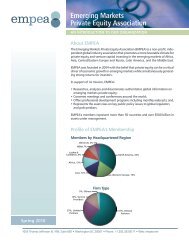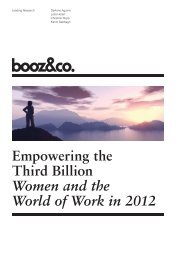Top 100 - Wamda.com
Top 100 - Wamda.com
Top 100 - Wamda.com
- No tags were found...
You also want an ePaper? Increase the reach of your titles
YUMPU automatically turns print PDFs into web optimized ePapers that Google loves.
Brand IndiaColorful, confident and creativeBrandZ <strong>Top</strong> <strong>100</strong> 2011: OPPORTUNITIES/RESOURCES 96Economic growth is driving brandpresence in India.India’s largest private bank, ICICI, appeared for a secondconsecutive year in the BrandZ <strong>Top</strong> <strong>100</strong> ranking, at No.53, with a brand value of $14.9 billion.With a rise of 27 percent in brand value to $8.2 billion,Infosys was one of the most valuable technology brandsin the world and is expected to soon rank among the <strong>Top</strong><strong>100</strong> Most Valuable Global Brands across all sectors.The IT services and consulting brand operates in33 countries.The appearance of Indian banking and technology brandsin the BrandZ ranking reflects both the prominence ofthese sectors in fast-growing markets and an expansionin brand literacy particular to India.Brands that many Indians until recently saw only in thesuitcases of relatives returning from North America orEurope are now encountered every day in local shopwindows. Indians appreciate the opportunity to ownbrands as living circumstances in India steadily improve.Perhaps drawn by the novelty of the brand explosion,Indian consumers even enjoy advertising.In a multiplier effect, the more that Indian consumersare exposed to brands, the more they desire them. Theexpanding middle class of educated young people,often employed in technology, especially exercises itspurchasing power. And economic progress, particularlyleadership in information technology, has altered India’simage of itself as well as the world’s postcard view ofIndia as simply colorful and exotic.That view also has changed because of the internationalreach of ICICI, Infosys and large Indian conglomerates,such as Tata, which operates in more than 80 countriesand gains annual revenue of almost $68 billion frombusinesses including steel, chemicals, hospitality and<strong>com</strong>munications. The recent acquisition of JaguarLand Rover made Tata a player in the luxury end of theinternational car business.Energy, confidence, creativity and purpose characterize“Brand India” today and point to its potential.The growth of “Brand India” could be restrained byan Indian inclination to look to the past or to the Westfor inspiration. But more likely, Indian brands willsurge ahead, powered by a <strong>com</strong>bination of positivefundamentals – economic vitality, a diverse andenterprising population and a cohesive, stable, muddled,democracy.Choice brings challengesThe increase in brand choice, with many internationaloptions, challenges Indian brands. While desired, Indianbrands <strong>com</strong>e weighted with both the advantages anddisadvantages of being familiar. Sometimes, they’re seenas too available and insufficiently aspirational.The Indian conglomerate brand Godrej exemplifies thistrend. Well respected across many product categories,the brand faces international <strong>com</strong>petition from LG,Samsung and Whirlpool, just in its appliance business.In cars, Maruti (the Indian brand of Suzuki) facesincreased <strong>com</strong>petition from international contendersincluding Honda, Toyota and BMW.Some of the Unilever and P&G brands, long establishedin India and seen as local, now are emphasizing theirglobal credentials. Advertising for Dove, for example,features not only Indians, but also women from manybackgrounds. Consumers view brands like L’Oréalor Garnier as international and delivering the qualitythat implies.Large Indian conglomerates, such as Bharti, Godrej,Reliance and Tata, occupy an influential and secureplace in the minds of consumers. Trusted, evenrevered, these conglomerate brands regularly introduceconsumers to new product categories. Although aconglomerate may itself be new to a category, its brandguarantees <strong>com</strong>petence and <strong>com</strong>pensates for any lackof experience.Major brands evoke trustIndians rely on these conglomerate brands for relativelyrisk-free introductions to new products and experiences.For example, a new retail format unusual for Indiaopened in Mumbai in 2005. The up-market gourmet storeoffered delicacies from around the world. Consumersimmediately accepted the new format because it camewith a reassuring brand. The store, called Godrej Nature’sBasket now operates in 13 locations in Delhi, Puneand Mumbai.The conglomerate brand be<strong>com</strong>es especially importantin high-risk, high-investment ventures. Tata moved intoreal estate – from high-rises in Bangalore to housingdevelopments in Delhi. In a similar way, India’s ITC Ltd.began diversifying its portfolio during the past decadebecause of the health issues and regulatory challengesfaced in its core business, cigarettes. ITC now marketsfood, hotels, personal care and cosmetics and otherfashion-focused products and services.In a country known for traditional mom-and-pop stores,the conglomerates are introducing modern retailing.Reliance, India’s largest private-sector enterprise,operates in many retail channels, including food, apparel,footwear, home improvement and consumer electronics.
















